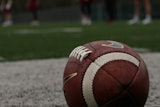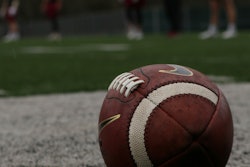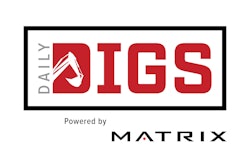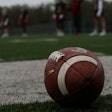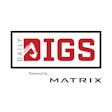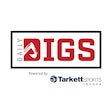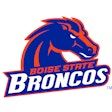A different breed of outdoor field sports is emerging, increasing the demands for versatility from fields and athletic programs everywhere

Athletic directors and field supervisors accustomed to tweaking schedules and grooming fields according to the needs of the "big three" outdoor field sports - football, baseball and soccer - could very soon experience some major shocks to their systems. A different breed of outdoor field sports is emerging, and fans and participants looking for fresh alternatives to this country's well-established pastimes are flocking to see what sports such as rugby, lacrosse and field hockey are all about. The rapid growth of these sports has increased the demands upon fields and athletic programs across the country, challenging athletic administrators to accommodate them, in addition to their pre-existing field sports programs.
Because each sport's needs and style of play vary, it won't suffice to simply allot one field to accommodate all three. Each is highly specialized - for example, field hockey (a ball-roll sport) shouldn't be played on crowned fields. On the other hand, such fields can easily accommodate a rugby game.
In many ways, rugby - often referred to as the predecessor of modern American football - closely resembles its successor. But even though it is believed by many in this country to be dangerous, it is a game well-suited for both sexes and most any body type, says Doug Arnot, chief executive officer of USA Rugby, the sport's governing body in the United States. "A kid that's a tad small for the college football team can still be a good college rugby player."
Arnot offers that distinction as a leading reason for rugby's popularity on college campuses, especially in California, where there are men's and women's clubs at more than 40 schools. Nationwide, there are more than 600 men's and women's club programs, making rugby the most popular college club sport in the country. While there are no men's varsity programs, the first women's varsity team began play at Eastern Illinois University in 1998, and just last year rugby was added to the NCAA's list of emerging women's sports.
Interest in rugby is also trickling down to the high school ranks. In recent months, youth club teams have taken root in cities such as New Orleans; Houston; Phoenix; San Antonio; Raleigh, N.C.; and Columbia, S.C. Arnot estimates that the number of U.S. rugby players is growing at a rate of 10 to 15 percent a year and will exceed 60,000 by year's end. "Kids like rugby because it's different. It's a little out of the mainstream," he says. "Most people see it as kind of an extreme sport."
In Arizona, lacrosse is usually given a similar branding by those unfamiliar with the sport. Seven years ago, Rich McAbee encountered just that when he packed his bags and moved his family from the East Coast to the suburbs of Phoenix. Once he arrived, the native New Yorker took it upon himself to spread the gospel of lacrosse.
It would appear that McAbee's proselytizing has been successful. In 1997, McAbee and three other Phoenix men formed a youth lacrosse league, assembling 67 boys to field four club teams. Today, the Arizona Youth Lacrosse League boasts 19 boys' and 13 girls' varsity high school club teams and 10 junior varsity club teams, with a total of 2,200 participants.
The sport has yet to be sanctioned by the Arizona Interscholastic Association, but McAbee, president of the AYLL, believes that day isn't too far off. "Realistically, I give it two years," he says. "If you come and watch lacrosse, it's like a magnet."
In recent years, greater numbers of fans have been drawn to the game as two professional leagues present the game to national audiences. Meanwhile, participation numbers are blossoming. According to the National Federation of State High School Associations, there were 81,392 high school lacrosse players last year, a 10 percent increase from 2001.
Lacrosse, and not baseball, is America's oldest sport, having been played on this continent for at least five centuries. Native American tribes inhabiting present-day northern United States and southern Canada developed the game, its original purpose to prepare warriors for battle. Seventeenth-century French pioneers who first witnessed the competitive war games were drawn to lacrosse's fast pace and its players' high level of skill, elements that still serve as attractions today. "American sports fans love hitting, scoring and speed," says Jake Steinfeld, co-founder of the two-year-old Major League Lacrosse outdoor professional league, but perhaps better known for his "Body by Jake" fitness franchise. "This game has it all."
Lacrosse is also appealing because, compared to football or hockey, it is relatively inexpensive to play. According to Brian Logue, director of communications for US Lacrosse, outfitting a novice male player costs approximately $200, including helmet, stick, gloves and pads. At an average of $100, the helmet is the costliest lacrosse staple, while sticks can range anywhere from $25 for beginners to $400 for elite players. Because it is non-contact, the female version of lacrosse is even less expensive, requiring only the purchase of a mouthguard and a stick. Some females opt to use gloves, as well.
Considering how accessible lacrosse is, it's little surprise that youth leagues are popping up across the country. In addition to Arizona, hotbeds have sprouted within the past several years in Georgia, Texas, Florida and southern California. Before he started a youth league there in the spring of 2000, Steinfeld says that lacrosse was virtually nonexistent in the Los Angeles area. "This year, we'll have 1,000 middle school kids playing and 19 high schools competing at the club level," he says. The California Interscholastic Federation sanctioned the sport in 2001.
Logue says that transplants like McAbee and Steinfeld, who also hails from New York, are a primary reason for lacrosse's movement to the country's western and southern regions. "A lot of times somebody who played his whole life in Maryland or New York moves out to Arizona and he wants the chance for his kid to play lacrosse," he says. "It's amazing what's happening in so many parts of the country where one person has the passion and the spark to get it going."
It also helps that two professional leagues are putting the sport in arenas and stadiums and on TV screens, with young spectators as the target audience. The younger of the two, Major League Lacrosse was founded in 2000 and has franchises in Baltimore; Boston; Bridgeport, Conn.; Bridgewater, N.J.; and in Long Island and Rochester, N.Y. Despite its East Coast base, the league's contract with cable's Fox Sports Net has led to the broadcast of MLL games in various regions of the country. According to Steinfeld, the league's TV popularity is greatest in the Sacramento, Calif., market.
The National Lacrosse League, meanwhile, is in the midst of its 16th season. The NLL combines elements of the outdoor game and box lacrosse, which is played inside the confines of a standard hockey rink. The NLL version, played in arenas with synthetic turf, is both fast-paced and high-scoring. The league's 12 franchises play in cities scattered across Canada and the northeastern United States, but the NLL is now spreading westward. Next season, an expansion franchise is planned to begin play in the San Jose, Calif., area, and if the success of the recently relocated Colorado Mammoth (formerly the Washington Power) is any indication, the NLL's fortunes are looking up. "They've had one sellout crowd and twice had crowds of 16,000," says NLL director of public relations Doug Fritts of the Mammoth, which play at the 18,000-seat Pepsi Center in downtown Denver. "They're on pace to set a new league record for attendance. It has really caught fire out there."
Field hockey is another sport that is beginning to catch on in Colorado. Poudre School District in Ft. Collins, Colo., added field hockey in 1998, and officials there have since seen a fledgling program rise from club-level status to a varsity sport with 70 participants. In this country, field hockey is played primarily by women, and Poudre's program offers girls there an additional athletic opportunity (because it is still relatively new, the district fields only one varsity team for field hockey, unifying student-athletes from several of its schools).
Although field hockey has been a hit in Poudre, participation nationally has remained flat in recent years. According to the NFHS, participation dropped from 61,110 participants in 2001 to 60,931 in 2002.
After experiencing no growth from 1998-99 to 200001, the collegiate ranks saw 13 new field hockey programs added in 2001-02. Despite the modest figures, Heather Lewis, president of the National Field Hockey Coaches Association and head coach at Bucknell University, doesn't think the sport has quite reached its peak. "As universities look to add more opportunities for women, field hockey's always one of the sports that's brought up," she says. "As long as there's some growth, it's a positive thing."
Ideally, field hockey - which may best be described as a combination of ice hockey and soccer - is played on flat fields, but a lack of field space currently has Poudre's team using the school district's crowned middle school fields.
But the field hockey program won't be relegated to Poudre's middle school fields for much longer. The school district is opening its fourth high school next year, and the competition field there - which will likely feature a synthetic surface - will have game lines sewed in for football, soccer and field hockey.
For Poudre field hockey coach Tami Agne-Moehle, the move can't come soon enough. "Crowned fields wreak havoc for us," she says. "The ball runs right off." Not only do the field hockey fields need to be flat, the grass needs to be very short, no longer than 1 1 / 4 inches, to facilitate ball roll. "I tell our groundskeepers how short they need to cut it and their jaws drop," says Agne-Moehle.
That's one of the reasons why synthetic fields are on the wish list of field hockey programs all over the country. All international play takes place on synthetic turf. Coaches and players prefer these fields because they are free of the divots inherent to natural turf, allowing players to enhance their ball-handling skills and footwork. Also, if designed with proper drainage systems, synthetic fields can be flat without risk of flooding. Interestingly enough, field hockey fields with carpet-like surfaces are often doused with water before games, a practice credited with reducing both player injury and friction between the ball and the turf, thus increasing the speed of the game.
Seventeen hundred miles east of Ft. Collins, the field hockey team at Pequea Valley (Pa.) High School - a longtime fixture of its athletic program - is seeing school officials make a firm commitment to its future. Work on a $2.4 million athletic fields improvement project is slated to begin there next month. The project will add five new natural-grass practice fields, but its centerpiece is a $600,000 synthetic-turf competition field. Pequea Valley officials can't wait to see how well the surface, which will also be used for football and soccer, accommodates its field hockey team. "The manufacturer thinks it'll be fine for field hockey, but I've also heard the other side of it, where with 2 1/2 inches of synthetic turf and sand and rubber infill, it's actually a little slow for field hockey," says Pequea Valley athletic director Rich Eby. "The jury's still out on that, although my field hockey coach is champing at the bit to see how it works."
Husson College athletic facilities manager Keith Bosley, whose school in Bangor, Maine, recently installed a similar synthetic field that's also used by the baseball and football programs, is pleased with the surface's performance for field hockey. "Ours is still faster and truer than any natural field," he says. "It's not as fast as the carpet; that's like playing pool. But the ball doesn't hop and jump like it would on a natural field."
Even if Pequea Valley's new turf isn't the fastest field hockey surface available, Eby figures that balanced with the field's durability and low maintenance, it's the best fit for his school. "It all came down to flat-out usability," says Eby. "Our campus does not have a lot of fields and they're getting beat up. Teams have to practice on the competition fields, plus the community doesn't have a lot of fields, so they use ours. There are some schools that dump $40,000 a year into their competition field. Obviously we don't have to do that now."
A few field hockey programs have resisted installing synthetic fields, opting instead to play on Bermudagrass turf. Such fields are used exclusively for field hockey at seven of the Howard County (Md.) Public School System's 11 high schools. "It's tough and aggressive, and I can perform the maintenance in the summertime when the kids aren't there," says Greg Connor, Howard County's assistant grounds manager. "Bermudagrass is also relatively disease- and insect-free, tolerates close mowing and has a high recuperative capacity."
Despite the potential advantages of Bermudagrass field hockey fields, Howard County's fields are somewhat of a rarity, not just within the Beltway area but at the high school level on the whole. To Connor's knowledge, only one other Maryland school district uses Bermudagrass fields, in neighboring Anne Arundel County. At the collegiate level, the fields are even more scarce. Lewis estimates that nationwide as many as 85 percent of NCAA Division I collegiate field hockey programs play on carpet-like synthetic turf. The choice of surface at schools in Divisions II and III varies between infill and carpet turf.
As a result, colleges that utilize grass have trouble scheduling home games. Division I Radford University, located approximately 40 miles southwest of Roanoke, Va., plays on Bermudagrass. Or it would, if it could get college teams to agree to play there. "We were in one conference where they said they wouldn't play on the grass, so we had to play every game away," says Radford head coach Jeff Woods of the program's former Colonial Athletic Association opponents. "The ACC schools also refuse to play on grass."
Radford eventually left the Colonial to join the transcontinental NorPac Conference, an association established especially for Division I field hockey programs (Radford's other 18 varsity sports compete in the Big South Conference). The NorPac has three members in California and five others in Missouri, North Carolina and Virginia. Only one other NorPac school - the University of the Pacific - plays on Bermudagrass. This fall, Radford, a NorPac East school, will play 17 of its 20 games on the road.
Woods knows the reason for the mass grass boycott is that schools that play on predictable turf aren't willing to subject their athletes to the uncertainties of a bumpy, natural field. And while he places synthetic turf near the top of his wish list, short of a private benefactor donating generously to Radford's field hockey program, Woods isn't counting on a new field anytime soon.
Meanwhile, as Husson's new field sees its first action this month, Bosley can't help but count his blessings. A minor league baseball team is now considering a partnership that would make Husson's field its home, and several regional colleges are requesting to borrow the field until the New England mud season passes. The revenue-generating opportunities are suddenly endless, seldom possible for facilities housing non-revenue sports such as field hockey. Obviously at Husson, the sport has come a long way.
Field hockey's financial coming-of-age at Husson could be a harbinger of what's in store for other emerging field sports. Next month, lacrosse fans will be treated to what could be the sport's best-attended - and most profitable - event in this country yet. Baltimore's Ravens Stadium will host the NCAA Men's Lacrosse Championships, a five-game event including the Divisions I and III semifinals and finals, and the Division II final.
This will mark the first time in its 33-year history that the tournament is being held at an off-campus venue. Rutgers University and the University of Maryland had shared host duties since 1993, and while Division I and III games were held in the schools' football stadiums, the Division II final was staged at a smaller campus venue.
In recent years, the four Division I and III games have drawn crowds of more than 30,000, consistently putting lacrosse's Final Four among the five best-attended of the NCAA's 87 championship tournaments. Ravens Stadium, without opening the upper deck, can accommodate 40,000 fans. The stadium's capacity, coupled with the popularity of lacrosse in the Baltimore area, has tournament organizers anticipating record crowds.
But their vision doesn't stop there. The Lax4Baltimore Organizing Committee also hopes the NCAA, which agreed to stage its lacrosse championships in Ravens Stadium next year as well, will eventually make Baltimore the tournament's permanent home, just as Omaha, Neb., has established itself as the home of the College World Series. "They've got a great facility for it," says Logue of Lax4Baltimore. "They think they're going to make it so good that the NCAA won't want to leave."
Who's to blame the NCAA if it doesn't? It appears that lacrosse - along with field hockey and rugby - is poised to help introduce a new era of outdoor field sports. In many parts of the country, athletic directors and facility managers are still learning how to accommodate these new sports as well as programs for football, baseball and soccer. "The greatest challenge I see is handling the explosive growth. On the West Coast, or at least in L.A., there's a lack of field space and a lack of talented coaches and referees," says Steinfeld. At the same time, though, he's encouraged by lacrosse's potential. "I can't tell you how many people have come up to me and said, 'Your sport is where soccer was in 1983.' It's become the fastest-growing game in the country."













